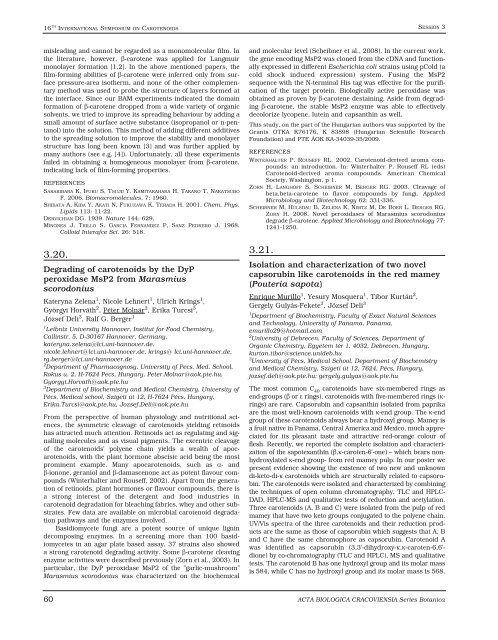ACTA BIOLOGICA CRACOVIENSIA
ACTA BIOLOGICA CRACOVIENSIA
ACTA BIOLOGICA CRACOVIENSIA
You also want an ePaper? Increase the reach of your titles
YUMPU automatically turns print PDFs into web optimized ePapers that Google loves.
16 TH INTERNATIONAL SYMPOSIUM ON CAROTENOIDS<br />
misleading and cannot be regarded as a monomolecular film. In<br />
the literature, however, β-carotene was applied for Langmuir<br />
monolayer formation [1,2]. In the above mentioned papers, the<br />
film-forming abilities of β-carotene were inferred only from surface<br />
pressure-area isotherm, and none of the other complementary<br />
method was used to probe the structure of layers formed at<br />
the interface. Since our BAM experiments indicated the domain<br />
formation of β-carotene dropped from a wide variety of organic<br />
solvents, we tried to improve its spreading behaviour by adding a<br />
small amount of surface active substance (isopropanol or n-pentanol)<br />
into the solution. This method of adding different additives<br />
to the spreading solution to improve the stability and monolayer<br />
structure has long been known [3] and was further applied by<br />
many authors (see e.g. [4]). Unfortunately, all these experiments<br />
failed in obtaining a homogeneous monolayer from β-carotene,<br />
indicating lack of film-forming properties.<br />
REFERENCES<br />
SAKAKIBARA K, IFUKU S, TSUJII Y, KAMITAKAHARA H, TAKANO T, NAKATSUBO<br />
F. 2006. Biomacromolecules, 7: 1960.<br />
SHIBATA A, KIBA Y, AKATI N, FUKUZAWA K, TERADA H. 2001. Chem. Phys.<br />
Lipids 113: 11-22.<br />
DERVICHIAN DG. 1939. Nature 144: 629.<br />
MINONES J, TRILLO S, GARCIA FERNANDEZ P, SANZ PEDRERO J. 1968.<br />
Colloid Interafce Sci. 26: 518.<br />
3.20.<br />
Degrading of carotenoids by the DyP<br />
peroxidase MsP2 from Marasmius<br />
scorodonius<br />
Kateryna Zelena1 , Nicole Lehnert1 , Ulrich Krings1 ,<br />
Györgyi Horváth2 , Péter Molnár2 , Erika Turcsi3 ,<br />
József Deli3 , Ralf G. Berger1 1 Leibniz University Hannover, Institut for Food Chemistry,<br />
Callinstr. 5, D-30167 Hannover, Germany,<br />
kateryna.zelena@lci.uni-hannover.de,<br />
nicole.lehnert@lci.uni-hannover.de, krings@ lci.uni-hannover.de,<br />
rg.berger@lci.uni-hannover.de<br />
2 Department of Pharmacognosy, University of Pecs, Med. School,<br />
Rokus u. 2, H-7624 Pecs, Hungary, Peter.Molnar@aok.pte.hu,<br />
Gyorgyi.Horvath@aok.pte.hu<br />
3 Department of Biochemistry and Medical Chemistry, University of<br />
Pécs, Medical school, Szigeti út 12, H-7624 Pécs, Hungary,<br />
Erika.Turcsi@aok.pte.hu, Jozsef.Deli@aok.pte.hu<br />
From the perspective of human physiology and nutritional sciences,<br />
the symmetric cleavage of carotenoids yielding retinoids<br />
has attracted much attention. Retinoids act as regulating and signalling<br />
molecules and as visual pigments. The excentric cleavage<br />
of the carotenoids' polyene chain yields a wealth of apocarotenoids,<br />
with the plant hormone abscisic acid being the most<br />
prominent example. Many apocarotenoids, such as α- and<br />
β-ionone, geraniol and β-damascenone act as potent flavour compounds<br />
(Winterhalter and Rouseff, 2002). Apart from the generation<br />
of retinoids, plant hormones or flavour compounds, there is<br />
a strong interest of the detergent and food industries in<br />
carotenoid degradation for bleaching fabrics, whey and other substrates.<br />
Few data are available on microbial carotenoid degradation<br />
pathways and the enzymes involved.<br />
Basidiomycete fungi are a potent source of unique lignin<br />
decomposing enzymes. In a screening more than 100 basidiomycetes<br />
in an agar plate based assay, 37 strains also showed<br />
a strong carotenoid degrading activity. Some β-carotene cleaving<br />
enzyme activities were described previously (Zorn et al., 2003). In<br />
particular, the DyP peroxidase MsP2 of the "garlic-mushroom"<br />
Marasmius scorodonius was characterized on the biochemical<br />
SESSION 3<br />
and molecular level (Scheibner et al., 2008). In the current work,<br />
the gene encoding MsP2 was cloned from the cDNA and functionally<br />
expressed in different Escherichia coli strains using pCold (a<br />
cold shock induced expression) system. Fusing the MsP2<br />
sequence with the N-terminal His tag was effective for the purification<br />
of the target protein. Biologically active peroxidase was<br />
obtained as proven by β-carotene destaining. Aside from degrading<br />
β-carotene, the stable MsP2 enzyme was able to effectively<br />
decolorize lycopene, lutein and capsanthin as well.<br />
This study, on the part of the Hungarian authors was supported by the<br />
Grants OTKA K76176, K 83898 (Hungarian Scientific Research<br />
Foundation) and PTE ÁOK KA-34039-35/2009.<br />
REFERENCES<br />
WINTERHALTER P, ROUSEFF RL. 2002. Carotenoid-derived aroma compounds:<br />
an introduction. In: Winterhalter P, Rouseff RL (eds)<br />
Carotenoid-derived aroma compounds. American Chemical<br />
Society, Washington, p 1.<br />
ZORN H, LANGHOFF S, SCHEIBNER M, BERGER RG. 2003. Cleavage of<br />
beta,beta-carotene to flavor compounds by fungi. Applied<br />
Microbiology and Biotechnology 62: 331-336.<br />
SCHEIBNER M, HÜLSDAU B, ZELENA K, NIMTZ M, DE BOER L, BERGER RG,<br />
ZORN H. 2008. Novel peroxidases of Marasmius scorodonius<br />
degrade β-carotene. Applied Microbiology and Biotechnology 77:<br />
1241-1250.<br />
3.21.<br />
Isolation and characterization of two novel<br />
capsorubin like carotenoids in the red mamey<br />
(Pouteria sapota)<br />
Enrique Murillo1 , Yesury Mosquera1 , Tibor Kurtán2 ,<br />
Gergely Gulyás-Fekete3 , József Deli3 1Department of Biochemistry, Faculty of Exact Natural Sciences<br />
and Technology, University of Panama, Panama,<br />
emurillo29@hotmail.com<br />
2University of Debrecen, Faculty of Sciences, Department of<br />
Organic Chemistry, Egyetem tér 1, 4032, Debrecen, Hungary,<br />
kurtan.tibor@science.unideb.hu<br />
3University of Pécs, Medical School, Department of Biochemistry<br />
and Medical Chemistry, Szigeti út 12, 7624, Pécs, Hungary,<br />
jozsef.deli@aok.pte.hu; gergely.gulyas@aok.pte.hu<br />
The most common C 40 carotenoids have six-membered rings as<br />
end-groups (β or ε rings), carotenoids with five-membered rings (κrings)<br />
are rare. Capsorubin and capsanthin isolated from paprika<br />
are the most well-known carotenoids with κ-end group. The κ-end<br />
group of these carotenoids always bear a hydroxyl group. Mamey is<br />
a fruit native in Panama, Central America and Mexico, much appreciated<br />
for its pleasant taste and attractive red-orange colour of<br />
flesh. Recently, we reported the complete isolation and characterization<br />
of the sapotexanthin (β,κ-caroten-6'-one) – which bears nonhydroxylated<br />
κ-end group- from red mamey pulp. In our poster we<br />
present evidence showing the existence of two new and unknown<br />
di-keto-di-κ carotenoids which are structurally related to capsorubin.<br />
The carotenoids were isolated and characterized by combining<br />
the techniques of open column chromatography, TLC and HPLC-<br />
DAD, HPLC-MS and qualitative tests of reduction and acetylation.<br />
Three carotenoids (A, B and C) were isolated from the pulp of red<br />
mamey that have two keto groups conjugated to the polyene chain.<br />
UV/Vis spectra of the three carotenoids and their reduction products<br />
are the same as those of capsorubin which suggests that A, B<br />
and C have the same chromophore as capsorubin. Carotenoid A<br />
was identified as capsorubin (3,3'-dihydroxy-κ,κ-caroten-6,6'dione)<br />
by co-chromatography (TLC and HPLC), MS and qualitative<br />
tests. The carotenoid B has one hydroxyl group and its molar mass<br />
is 584, while C has no hydroxyl group and its molar mass is 568.<br />
60 <strong>ACTA</strong> <strong>BIOLOGICA</strong> <strong>CRACOVIENSIA</strong> Series Botanica












